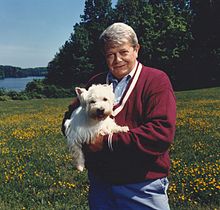Howard E. Simmons
Howard Ensign Simmons Jr. (born June 17, 1929 in Norfolk , † April 26, 1997 in Wilmington ) was an American industrial chemist.
Life
Simmon's paternal family went to sea, his mother was one of her ancestors Jacob Huebner . Simmons studied chemistry (as well as mathematics and physics) at the Massachusetts Institute of Technology with a bachelor's degree in 1951 with John D. Roberts and a doctorate in organic chemistry in 1954. He then went to DuPont (Central Research and Development, CR&D) as a research chemist , where he rose quickly. In 1959 he became a research supervisor. In 1983 he became Vice President for CR&D and in 1990 Senior Science Advisor. In 1992 he retired.
plant
The Simmons-Smith reaction , which converts alkenes into cyclopropanes, is named after him and Ronald D. Smith . He came across this while reading older German chemistry literature from the 1890s (reaction of methylene iodide with zinc-copper, producing a gas, possibly ethyne from the reaction of unstable carbenes ).
He worked with Nobel Prize winner Charles Pedersen on the synthesis of macrocyclic compounds of crown ethers (and coronates formed from them) as synthetic enzymes and catalysts. He was also interested in the application of topological methods in organic structural chemistry and wrote a book about it with Richard E. Merrifield .
As head of research, he successfully expanded research to include genetics, biotechnology, electronics, and materials science. During his time there were the replacement of ozone-damaging chlorofluorocarbons , group transfer polymerization , new electronic materials including those for high-temperature superconductors , advances in DNA sequencing technology, and supercomputer applications.
Honors and memberships
He received the Charles Goodyear Medal in 1952, the National Medal of Science in 1992 ( for fundamental contributions to the synthesis, molecular structure, and theory of organic chemistry and his productive management of the most important chemical industry research program in the United States ), and the Priestley Medal in 1994 . In 1976 he headed the Organic Chemistry Department of the American Chemical Society. He was a member of the American Philosophical Society , the American Association for the Advancement of Science (1981), and the National Academy of Sciences and the American Academy of Arts and Sciences (both 1975). He was an honorary doctor of the Rensselaer Polytechnic Institute and the University of Delaware, where he taught in retirement and lived in nearby Wilmington.
Private
His interests ranged from math to Mayan archeology and the study of Mayan hieroglyphics, as well as a sense of humor (he and an assistant edited an edition of a Bulletin of the Society for Heightened Interest in Topology to give the acronym SHIT establish). He spoke several languages, including German and French and, for example, gave a lecture in German in Heidelberg. He also had several boats on the Bohemia River on Chesapeake Bay .
He was married to Elizabeth Warren Simmons, whom he had known from school since 1951, and had two sons who both became research chemists at DuPont.
Fonts
- with Richard E. Merrifield: Topological Methods in Chemistry, Wiley 1989
Web links
- Obituary to the American Philosophical Society by Edward G. Jefferson, pdf
- Interview Chemical Heritage Foundation
Individual evidence
- ^ After the official laudation, quoted by Edward G. Jefferson in the obituary of the American Philosophical Society
| personal data | |
|---|---|
| SURNAME | Simmons, Howard E. |
| ALTERNATIVE NAMES | Simmons, Howard Ensign (full name) |
| BRIEF DESCRIPTION | American industrial chemist |
| DATE OF BIRTH | June 17, 1929 |
| PLACE OF BIRTH | Norfolk |
| DATE OF DEATH | April 26, 1997 |
| Place of death | Wilmington |
